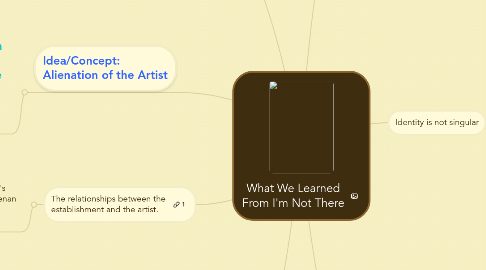
1. Idea/Concept: Alienation of the Artist
1.1. How: Seen through the distancing and outcasting of Dylan from society. Particularly shown in relationship between Jude Quinn & Keenan Jones where Quinn is criticised by the media and fans.
2. The relationships between the establishment and the artist.
2.1. Through the use of Keenan Jones and Dylan's songs. The antagonistic nature between Keenan and Jude. Keenan's need to explore Jude's motivation, thoughts and character.
2.1.1. This is a representation of the establishment's destruction of identity. By wanting to 'get to know' and artist, the media creates an artist who is unknowable because their representation of the artist is not a true representation of their identity. The fans and the media believe that the artist is fixed, and deified individual. The nondiegetic 'ballad of a thin man' show the artist's retaliation towards the establishment, as they think they can get to know the artist, but really they know nothing at all.
3. an artist can never escape
3.1. In I'm Not There the film has illustrated how trapped Dylan is as an individual and shows his journey of struggle which he goes through in his lifetime. Through the use of non diegetic sound his songs bring meaning to the idea of being trapped. "Out in your face just for kicks, his bedroom window made out of bricks" By Dylan not being truly in the film, we can see that he cannot escape even if he is not there physically.
3.2. The relationship between the Media and Jude Quinn also defines the Idea of solidarity through art. The demands of Quinns' audience becomes overwhelming and demanding which forces Quinn into an artistic confinement.
4. Symbolism of the gun.
4.1. When Jude and his band 'opened fire' upon the audience, before his electric set.
4.1.1. By opening fire upon his fans, Jude represents the disconnection between Dylan and his fans. This image shows how his audience felt they were literally being 'shot in the face' or betrayed by Dylan's change to electric. The projected relationship the audience created is thus shattered by Jude's act, bringing some sense of reality to Dylan's identity.
5. Idea: The Curse of the Artist
5.1. How: The sequence of Billy the Kid. Haynes draws on elements of Peckinpah's film. The reference of 'Pat Garret and Billy the Kid' alludes to Dylan's time in seclusion when he removed himself from the public eye.
5.1.1. Why: Billy the Kid goes into hiding to escape his past. In the same way artists want to escape the fixed image that the media tries to force them into. Just as Billy the Kid gets caught, we get the sense that the artist can never escape. Their creations are a sort of prison that comes to define them and fix them in the eyes of the audience and media.
5.2. How: Haynes' use of symbolism, specifically of the gun in one of Jude Quinn's sequences. Here Haynes alludes to the 'Warhol image' which represents the celebrities protecting the image that has been set up for them. With guns pointing at the audience, fans feel a violent disconnection from Quinn.
5.2.1. Why:
